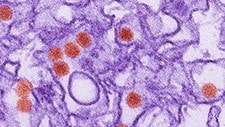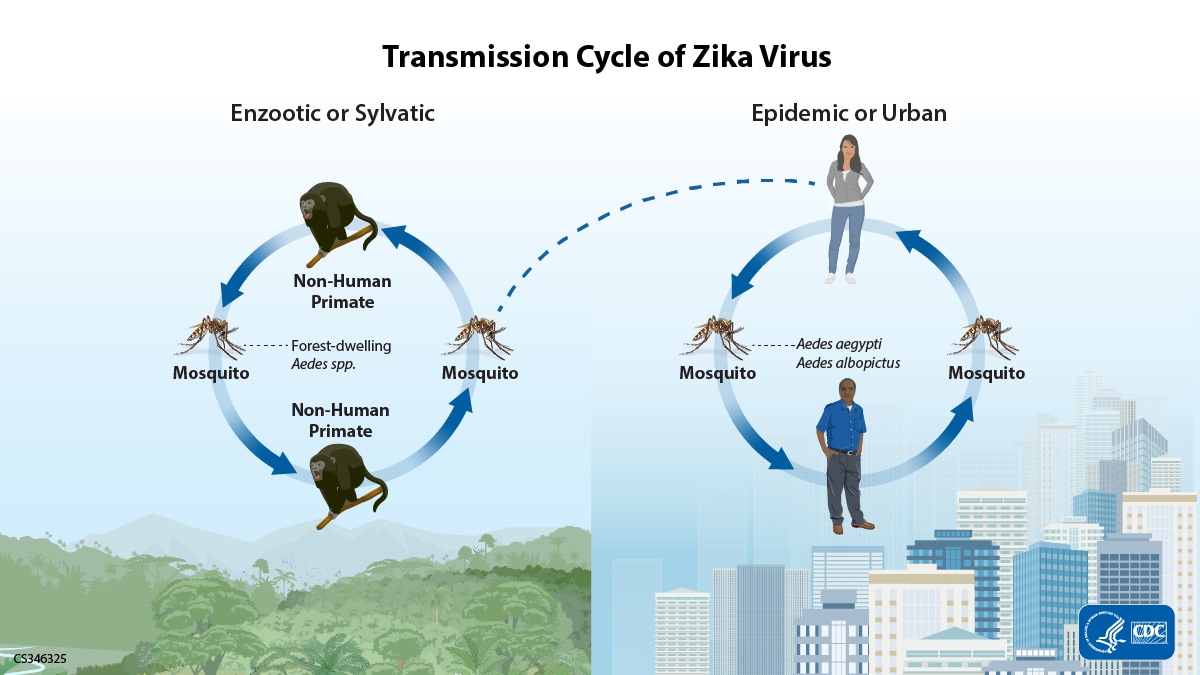Key points
- Zika virus is a flavivirus and is related to dengue, yellow fever, Japanese encephalitis, and West Nile viruses.
- Zika virus is primarily transmitted by Aedes species mosquitoes (Ae. aegypti and Ae. albopictus).
- Other modes of transmission include perinatal, in utero, sexual, and blood or laboratory exposure.

About Zika virus
Zika virus is a single-stranded RNA virus of the Flaviviridae family, genus Flavivirus. It is related to dengue, yellow fever, Japanese encephalitis, and West Nile viruses.
Virus particles are 40nm in diameter, with an outer envelope, and an inner dense core.
Transmission
Zika virus is maintained in an enzootic cycle (also called a sylvatic cycle). In an enzootic cycle, forest-dwelling Aedes species mosquitoes become infected when they feed on infected non-human primates. Infected mosquitoes can then transmit the virus to other primates (non-human and human).

When Zika virus is introduced into human populations that lack immunologic protection against Zika virus, transmission can occur in an urban cycle. In an urban cycle, urban-dwelling Aedes species mosquitoes (Ae. aegypti and Ae. albopictus) bite infected people and then transmit the virus to uninfected people. These mosquitoes typically breed in domestic water-holding containers; they bite during the day and night and feed both indoors and outdoors near dwellings. Ae. hensilli may also contribute to transmission in the Pacific Islands.
Zika virus can be transmitted from a person who is pregnant to their fetus during pregnancy (congenital transmission) or around the time of birth (perinatal transmission).
- Congenital or intrauterine (in utero) transmission of Zika virus occurs when a pregnant person is infected with Zika virus before delivery, and the virus passes to the fetus.
- Perinatal transmission of Zika virus occurs when a pregnant person is infected with the Zika virus within approximately 2 weeks of delivery, and the virus passes to the infant at or around the time of delivery. When an infant acquires Zika virus infection perinatally, the infant may develop symptoms such as maculopapular rash, conjunctivitis, arthralgia, and fever.
Zika virus has been found in breast milk. Possible Zika virus infections have been identified in breastfeeding babies, but Zika virus transmission through breast milk has not been confirmed.
CDC encourages breastfeeding.
Zika virus can be passed through sex from a person who has Zika virus infection to their partner(s). Zika virus can be passed through sex, even if the infected person does not have symptoms at the time.
- It can be passed from a person with Zika before their symptoms start, while they have symptoms, and after their symptoms end.
- The virus may also be passed by a person who carries the virus but never develops symptoms.
There have been no confirmed cases of Zika virus being spread by blood transfusion in the United States. However, cases of Zika virus transmission through platelet transfusions have been documented in Brazil. Because of the potential risk, the U.S. Food and Drug Administration (FDA) implemented Zika virus screening of blood donations in 2016. In May 2021, in response to the global decline in the incidence of Zika virus, FDA removed the requirement for routine Zika virus screening of blood donations. Certain human cell and tissue-based products, such as umbilical cord blood, gestational tissues, and reproductive tissues, can harbor Zika virus even months after the initial infection.
There are reports of laboratory acquired Zika virus infections, although the route of transmission was not clearly established in all cases.
To date, no cases of Zika virus transmission in healthcare settings have been identified in the United States.
